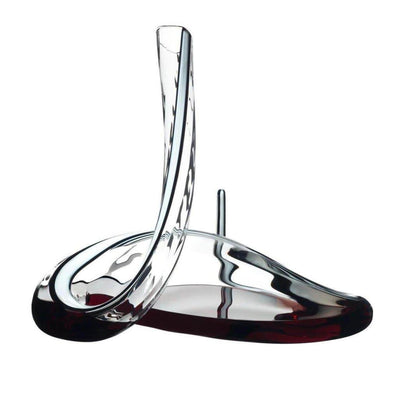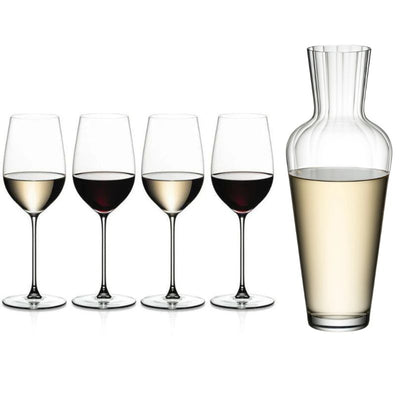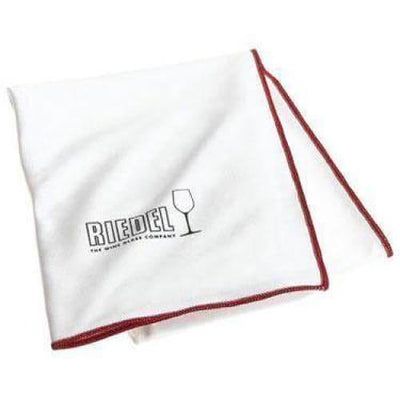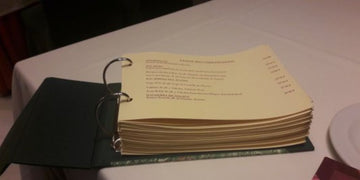The True Value in Riedel Glassware

Every week my inbox has a variation of the same question: “Are Riedel glasses really worth the money?”
Sometimes it's from a curious wine lover debating their first purchase, other times from someone who's just broken a glass and is weighing up whether to replace it or switch to something cheaper.
It's the eternal dilemma on theriedelshop.co.uk, the hesitation before checkout as customers wonder if they're paying for genuine craftsmanship or just an expensive brand name.
After years of customer feedback and my own experience with everything from budget supermarket glasses to the finest handblown crystal, I've developed a pretty honest perspective on what you're actually getting when you invest in Riedel.
Let's break down what's behind that price tag and whether these glasses genuinely enhance your wine experience or if you're better off saving your hard earned cash.
On the subject of saving you money, and in anticipation of the recent fantastic weather returning in the near future, we have got extra discounts on a range of Sauvignon Blanc Glasses. In the case of Veritas, Performance and Veloce, this means they are now 30% off the RRP, whilst Vinum and Grape are 27% and 33% off, respectively. These offers expire at midnight on Bank Holiday Monday.
The Riedel Story: Revolution in a Glass
The Riedel company has been making glass since 1756, but n the aftermath of World War II, the Riedel family lost its Bohemian holdings due to geopolitical shifts. The company reestablished itself in Austria under the leadership of Claus J. Riedel in the 1950s. Claus shifted their focus from decorative, luxury glassmaking to functional glassware.
In a radical departure from ornate tradition, he developed clean, unadorned crystal glasses that prioritised the sensory experience of wine, based on what seemed like a bonkers idea at the time: what if different wines needed different glass shapes?
Before this, wine glasses were mainly decorative objects—the fancier and more ornate, the better. Think heavy cut crystal that showed off the glassmaker's skill but did nothing special for the wine.
"My grandfather was considered quite eccentric for suggesting something as simple as glass shape could change how wine tastes," said Maximilian Riedel, the current CEO.
Whether stroke of genius or clever marketing, this idea - that the glass should be designed around the wine, not just to look pretty - changed everything. The egg-shaped bowls and narrower rims that Claus designed were radically different from the decorative glasses of the day.
Does Shape Really Matter?
Here's where things get interesting. While some wine experts might roll their eyes at the idea of needing 20 different glass shapes, there is some actual science behind how glass design affects your wine experience:
- Bowl size changes how aromas concentrate (think of how perfume, or aftershave, smells stronger when you put it on in a small bathroom, than it does when you go outdoors)
- Rim diameter affects where wine lands on your tongue, influencing your brain’s perception of the initial different flavours
- Opening width influences how quickly wine oxidises
- Glass thickness impacts temperature stability
In their tasting workshops, Riedel serves the same wine in different shaped glasses to decide which shape is best, and to demonstrate these differences.
And yes, the differences can be spectacular - though whether you need a specific glass for every grape variety is another question entirely.
As wine writer Jancis Robinson (who, ironically, has developed her own "one glass for all wines" in collaboration with another glassmaker) once noted: "The differences are real, but the need for dozens of shapes is perhaps driven as much by commerce as necessity."
How They're Made: Old School vs New Tech
Riedel makes glasses in two main ways, and knowing the difference helps explain the sometimes eye-popping price differences.
The Handmade Approach
Premium items like decanters and the Sommeliers range are still made the old-fashioned way:
- A glassblower gathers molten crystal on a blowpipe
- They blow and shape it by hand (yes, using actual lung power)
- With glasses, the stem and foot are attached while the glass is still hot
- The rim is cut and polished by hand
- Each glass is inspected individually
This process hasn't changed much in centuries, and it's pretty impressive to watch skilled craftspeople creating these delicate objects from glowing blobs of 1200°C crystal.
"Each mouth-blown glass passes through at least 20 pairs of hands," according to Riedel. Having seen their factory in action, I can confirm this isn't just marketing speak - it's genuinely labour-intensive work.
The Decanter Difference: Artistry in Motion
Nowhere is the glassblower's art more evident than in Riedel's mouth-blown decanters. While their machine-made decanters are perfectly functional, the handcrafted pieces like the Amadeo, Mamba, and Cobra’s are genuine works of art that also happen to serve wine.
The skill required to create these complex shapes is staggering. The concentration needed is intense; one wrong move or temperature miscalculation would ruin the entire piece.
For the most complex decanters, apprentice glassblowers train for years before they're allowed to attempt them unsupervised. The serpentine forms of decanters like the Boa or Mamba require exceptional breath control and hand-eye coordination—skills that simply can't be rushed or automated.
"A good glassblower can make a standard wine glass in minutes, but our sculptural decanters require a different level of mastery. We're talking about skills that take 10 - 15 years to truly perfect."
What's remarkable is how these artisans work almost entirely by eye, without measuring tools. They judge wall thickness, symmetry, and volume purely from experience and muscle memory, creating remarkably consistent pieces despite the inherent variability of handcrafting.
The process is physically demanding too. Glassblowers work in short, intense shifts near furnaces reaching 1300°C, constantly rotating the blowpipe to prevent the molten crystal from drooping while simultaneously blowing with precise pressure to create the desired form.
Actually breathtaking! Take a look...
True craftsmen at work!
The Machine Method
For the more affordable ranges like Veritas, Vinum, and the O Series, Riedel uses modern machinery:
- Computer-controlled furnaces melt the crystal
- Automated machines form the bowls and stems
- Laser cutting creates clean rims
- Polishing happens at high temperatures
- Quality control combines computer and human inspection
These glasses are still well-made, but the automation explains why you can pick up a machine-made Riedel for £20-30 instead of £80-100 for the handmade versions.
What's In the Glass?
Crystal isn't just fancy glass—there's a chemical difference. Traditional crystal used to contain lead oxide (up to 24%), but now, their lead-free crystal uses different minerals like barium.
These additions create some noticeable properties:
- That distinctive "ping" sound when you tap it
- The ability to make thinner, stronger walls
- More sparkle and brilliance
- Better workability at lower temperatures
The biggest practical advantage for wine lovers is how thin the rim can be while still maintaining strength. A chunky rim is like drinking from a jam jar - it gets in the way of the wine.
The Superleggero Sweet Spot
If you're curious about Riedel's craftsmanship but don't want to remortgage your house, the Superleggero ("super lightweight") collection is worth a look.
These glasses show off some impressive technical achievements - stems pulled remarkably thin while maintaining strength, and bowls so fine they almost disappear visually while you're drinking.
The goal was to create something delicate that can still survive restaurant use. "It's about finding that balance between extreme thinness and practical durability."
Having accidentally smashed my fair share of wine glasses over the years, I'm still dubious about "extreme thinness" and "durability" coexisting, but Riedel glasses are genuinely more resilient than they look, thanks to that crystal composition.
The Pricing Question
Let's be honest—Riedel glasses aren't cheap. So what exactly are you paying for?
- Design research - They conduct extensive sensory workshops, rather than everything being born on a drawing board.
- Materials quality - Better crystal does cost more.
- Craftsmanship - Especially in the handmade ranges.
- Brand reputation - Yes, you're paying for the name too.
- That little oval sticker - Just kidding!
So, is it worth it?
That depends entirely on how much you care about wine and what your budget allows. If you're opening special bottles regularly, good glassware is essential. If you primarily drink supermarket wine, maybe not, but it will improve the palatability.
I've gradually built my collection over the years, starting with just a pair of Bordeaux glasses and slowly adding others. The difference is noticeable enough that I don't regret the investment - but I've also been known to serve wine in IKEA glasses when we have a full house, and nobody has died of disappointment yet.
Keeping Them Alive
If you do invest in Riedel, here's how to avoid turning them into very expensive recycling:
- Hand washing is gentler, though most are dishwasher-safe.
- Avoid drastic temperature changes that can cause cracking.
- Store them upright rather than inverted to protect the rims
- Hold them by the stem to avoid fingerprints and keep wine at the right temperature
- Use microfiber cloths for polishing to avoid scratches
With decent care, quality glassware can last for decades. I still use Vinum glasses I bought in the 10 years that look as good as new (the ones I haven't broken, anyway).
The Real Value Proposition
Here's a way to think about it: A good Riedel glass costs around £20 - £40 and will enhance every wine you drink for years. If you're regularly enjoying bottles in the £15+ range, the per-drink cost becomes pretty reasonable.
Let’s do the maths, 1 bottle per week, 5 glasses per bottle, for 10 years is 2,600 glasses of wine (scary!) A pair of Veritas glasses is £49.95, so £25 each, (let’s make the maths easy on ourselves!) that’s less than 1p per glass of wine!
Riedel glasses won't magically transform a £5 bottle of plonk into a fine wine, but they will make it taste better and will certainly help a good bottle show its best qualities—and isn't that the point?
The true value isn't about status or showing off. It's about how these glasses do their fundamental job: they help you enjoy wine more. After experimenting with different shapes over many, many bottles, I've found that the right glass really does make a difference to how wine tastes.
That said, you definitely don't need a different glass for every grape under the sun. A good, versatile red glass, a white glass, and perhaps a champagne glass will cover 95% of your wine drinking needs perfectly well.
If you enjoy more than the odd bottle of slightly less mainstream vino, like, say Oaked Chardonnay or Hermitage, then a specific glass for those will be well worth the investment.
After almost a decade selling these glasses online, I've come to accept certain truths:
Yes, Riedel makes exceptional glassware that genuinely enhances wine.
Yes, the craftsmanship justifies much of the price.
And yes, I am completely incapable of making it through a dinner party without breaking at least one glass, despite my supposed 'expert' status. Nothing establishes your wine credentials quite like explaining the delicate craftsmanship of a Veritas stem, moments before knocking it over while gesturing too enthusiastically about tannin structure.
My recycling bin too often tells the real story of my relationship with Riedel - a graveyard of beautiful craftsmanship that met its end at my clumsy hands. Perhaps I should stick to the machine-made ranges and leave those handblown masterpieces to people who don't consider 'not breaking anything' the crowning achievement of their dinner parties.
Still, I won't trade the experience of drinking from them... for however brief that experience might be in my house.





















Leave a comment